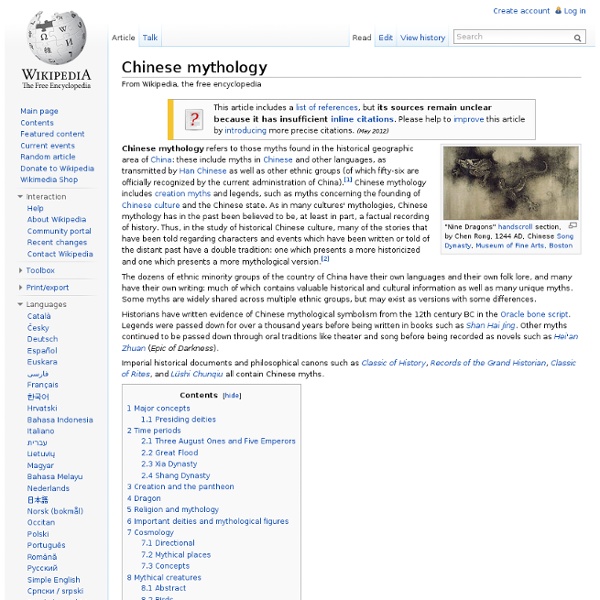Chinese mythology

Japanese mythology
Japanese myths, as generally recognized in the mainstream today, are based on the Kojiki, the Nihon Shoki, and some complementary books. The Kojiki, or "Record of Ancient Matters", is the oldest surviving account of Japan's myths, legends and history. The Shintōshū describes the origins of Japanese deities from a Buddhist perspective, while the Hotsuma Tsutae records a substantially different version of the mythology. One notable feature of Japanese mythology is its explanation of the origin of the imperial family which has been used historically to assign godhood to the imperial line. Note: Japanese is not transliterated consistently across all sources, see: #Spelling of proper nouns Creation myth[edit] In the Japanese creation myth, the first deities which came into existence, appearing at the time of the creation of the universe, are collectively called Kotoamatsukami. Kuniumi and Kamiumi[edit] From their union were born the Ōyashima, or the eight great islands of Japan:
Mesopotamian religion
The god Marduk and his dragon Mušḫuššu Mesopotamian religion refers to the religious beliefs and practices followed by the Sumerian and East Semitic Akkadian, Assyrian, Babylonian and later migrant Arameans and Chaldeans, living in Mesopotamia (a region encompassing modern Iraq, Kuwait, southeast Turkey and northeast Syria) that dominated the region for a period of 4200 years from the fourth millennium BCE throughout Mesopotamia to approximately the 10th century CE in Assyria.[1] Mesopotamian polytheism was the only religion in ancient Mesopotamia for thousands of years before entering a period of gradual decline beginning between the 1st and 3rd centuries CE. Reconstruction[edit] As with most dead religions, many aspects of the common practices and intricacies of the doctrine have been lost and forgotten over time. History[edit] Overview map of ancient Mesopotamia. Akkadian names first appear in king lists of these states circa 2800 BCE. Religion in the Neo-Assyrian Empire[edit] "Enlil!
Canaanite religion
Canaanite religion is the name for the group of Ancient Semitic religions practiced by the Canaanites living in the ancient Levant from at least the early Bronze Age through the first centuries of the Common Era. Canaanite religion was polytheistic, and in some cases monolatristic. Beliefs[edit] Pantheon[edit] Ba'al with raised arm, 14th-12th century BC, found at Ras Shamra (ancient Ugarit), Louvre A great number of deities were worshiped by the followers of the Canaanite religion; this is a partial listing: Afterlife; Cult of the Dead[edit] Cosmology[edit] So far, none of the inscribed tablets found in 1929 in the Canaanite city of Ugarit (destroyed ca. 1200 BC) has revealed a cosmology. From the union of El Elyon and his consort were born Uranus (Pronounced Oo(as in room)-ran-aws) and Ge (Pronounced Yee), Greek names for the "Heaven" and the "Earth". Mythology[edit] History[edit] The Canaanites[edit] Some[who?] Influences[edit] Contact with other areas[edit] Hebrew Bible[edit] Sources[edit]
Related:
Related:



